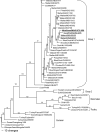Characterization of low-pathogenicity H5N1 avian influenza viruses from North America
- PMID: 17728231
- PMCID: PMC2168782
- DOI: 10.1128/JVI.01368-07
Characterization of low-pathogenicity H5N1 avian influenza viruses from North America
Abstract
Wild-bird surveillance in North America for avian influenza (AI) viruses with a goal of early identification of the Asian H5N1 highly pathogenic AI virus has identified at least six low-pathogenicity H5N1 AI viruses between 2004 and 2006. The hemagglutinin (HA) and neuraminidase (NA) genes from all 6 H5N1 viruses and an additional 38 North American wild-bird-origin H5 subtype and 28 N1 subtype viruses were sequenced and compared with sequences available in GenBank by phylogenetic analysis. Both HA and NA were phylogenetically distinct from those for viruses from outside of North America and from those for viruses recovered from mammals. Four of the H5N1 AI viruses were characterized as low pathogenicity by standard in vivo pathotyping tests. One of the H5N1 viruses, A/MuteSwan/MI/451072-2/06, was shown to replicate to low titers in chickens, turkeys, and ducks. However, transmission of A/MuteSwan/MI/451072-2/06 was more efficient among ducks than among chickens or turkeys based on virus shed. The 50% chicken infectious dose for A/MuteSwan/MI/451072-2/06 and three other wild-waterfowl-origin H5 viruses were also determined and were between 10(5.3) and 10(7.5) 50% egg infective doses. Finally, seven H5 viruses representing different phylogenetic clades were evaluated for their antigenic relatedness by hemagglutination inhibition assay, showing that the antigenic relatedness was largely associated with geographic origin. Overall, the data support the conclusion that North American H5 wild-bird-origin AI viruses are low-pathogenicity wild-bird-adapted viruses and are antigenically and genetically distinct from the highly pathogenic Asian H5N1 virus lineage.
Figures


References
-
- Alexander, D. J. 7 August 2005, most recent update. Manual of diagnostic tests and vaccines for terrestrial animals. Avian influenza. World Organisation for Animal Health, Paris, France. http://www.oie.int/eng/normes/mmanual/A_00037.htm.
-
- Capua, I., and D. J. Alexander. 2004. Avian influenza: recent developments. Avian Pathol. 33:393-404. - PubMed
-
- Donis, R. O., W. J. Bean, Y. Kawaoka, and R. G. Webster. 1989. Distinct lineages of influenza virus H4 hemagglutinin genes in different regions of the world. Virology 169:408-417. - PubMed
-
- Garcia, M., D. L. Suarez, J. M. Crawford, J. W. Latimer, R. D. Slemons, D. E. Swayne, and M. L. Perdue. 1997. Evolution of H5 subtype avian influenza A viruses in North America. Virus Res. 51:115-124. - PubMed
Publication types
MeSH terms
Substances
LinkOut - more resources
Full Text Sources
Other Literature Sources
Medical

